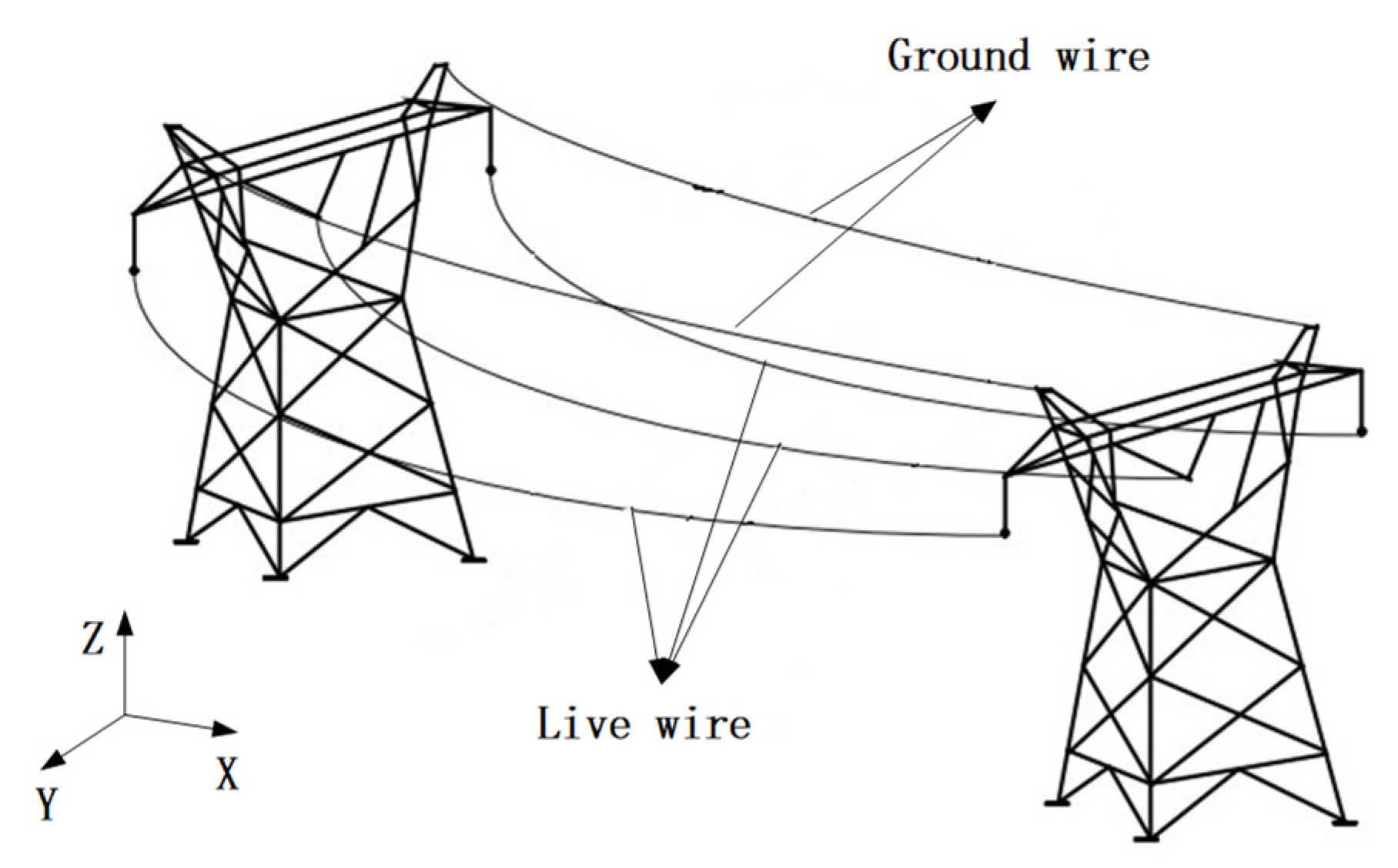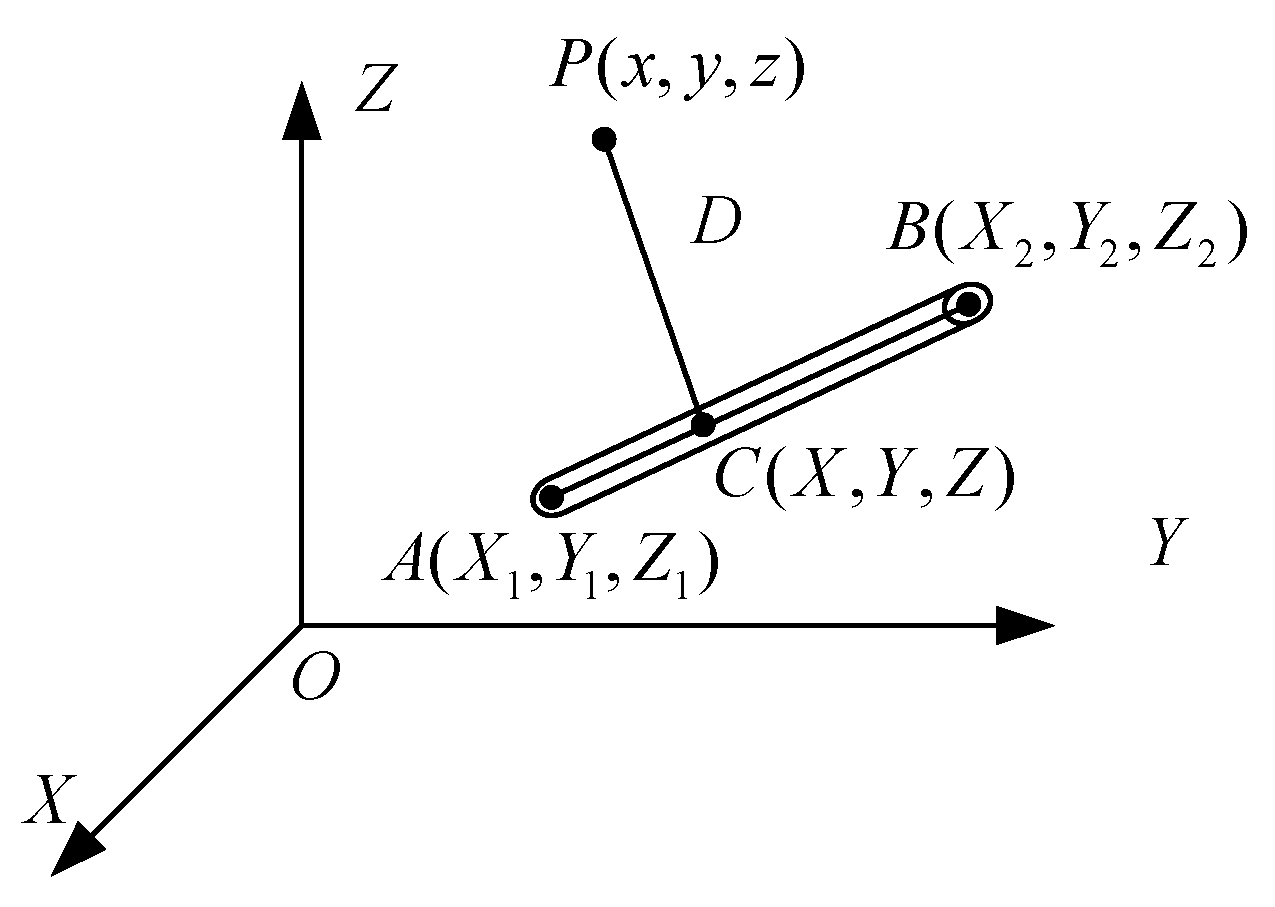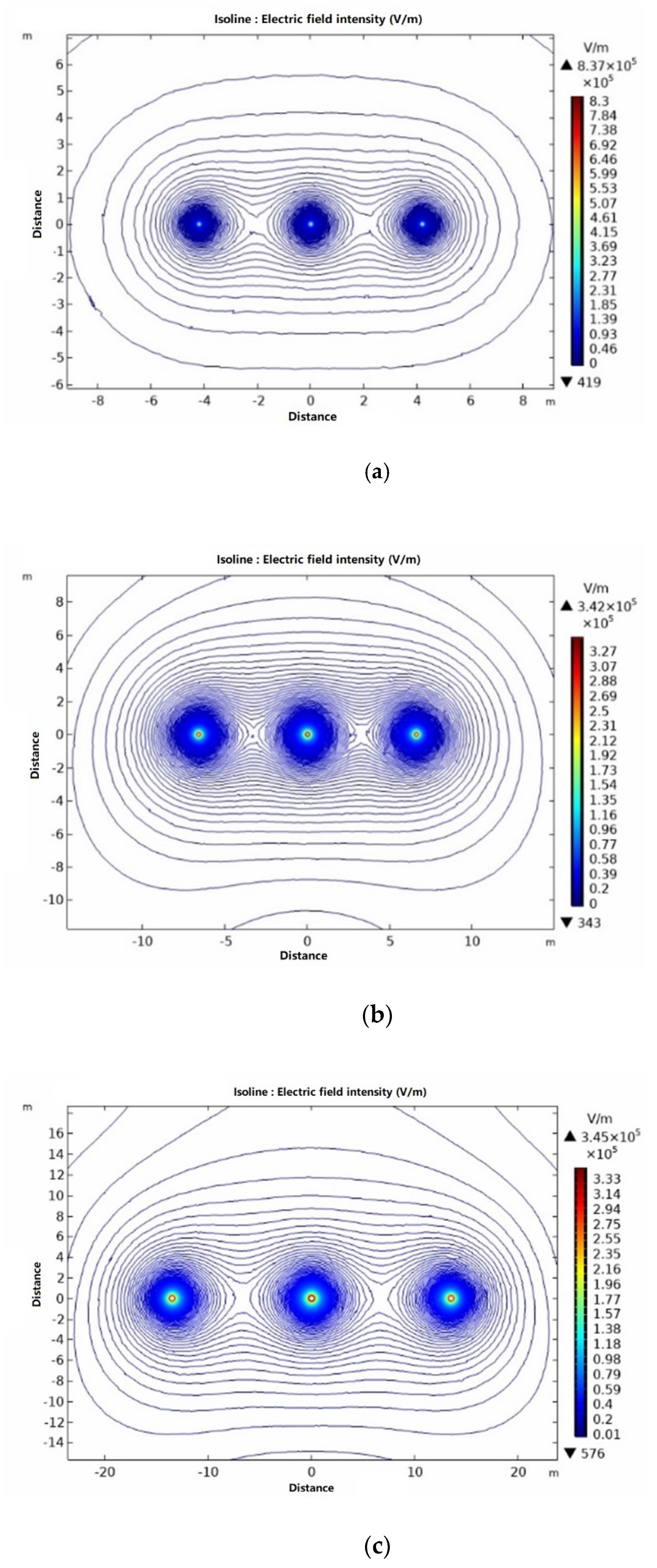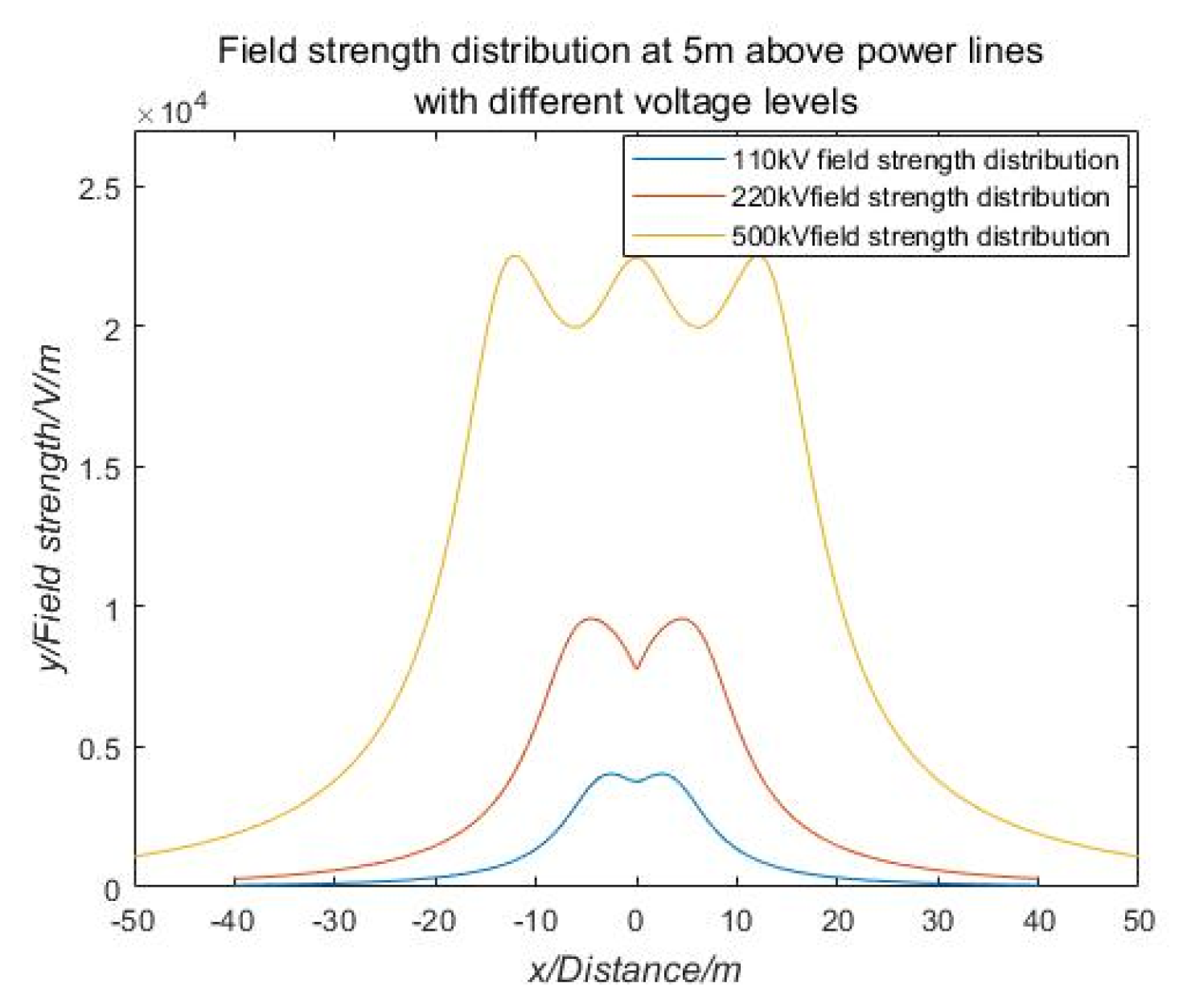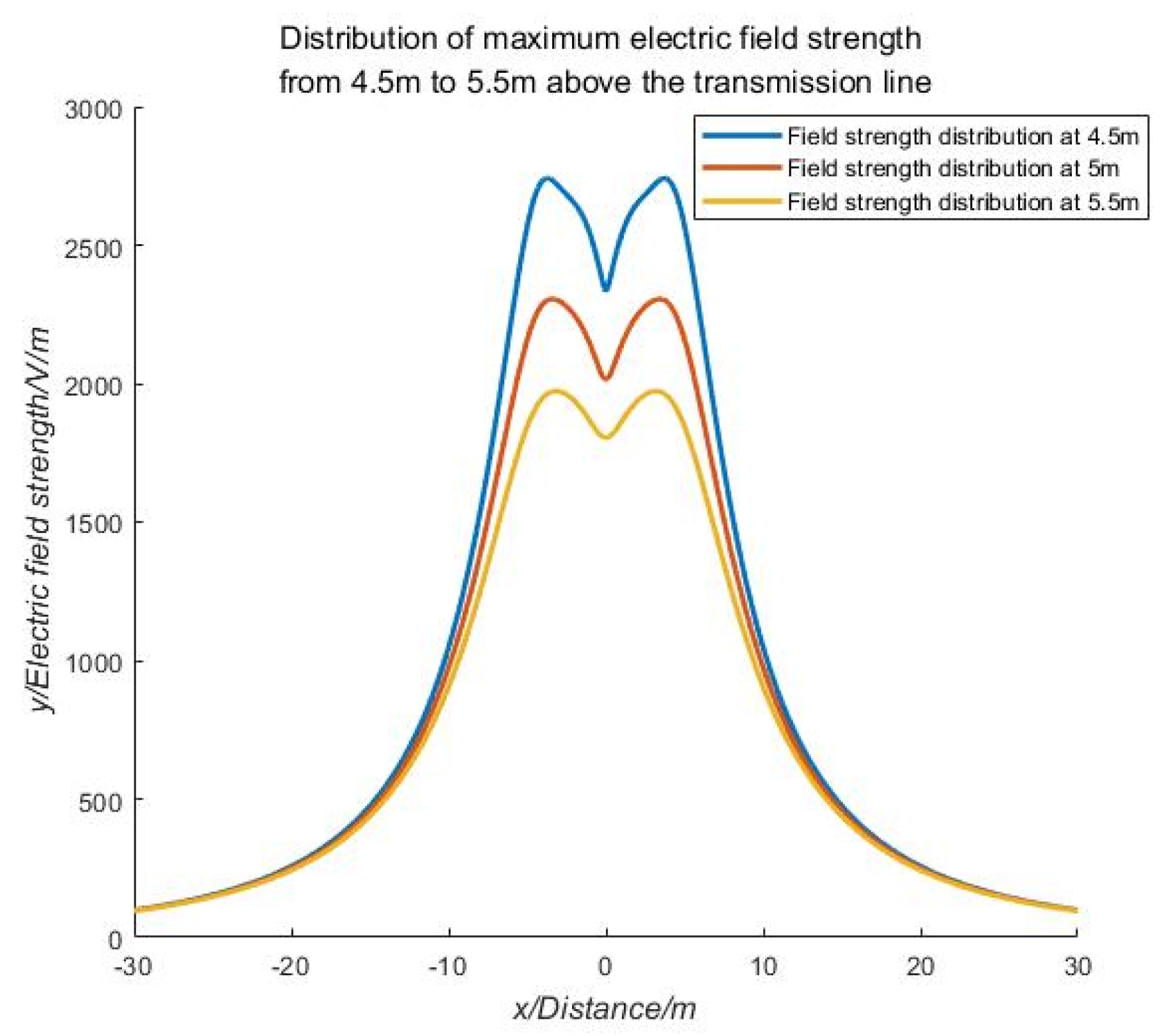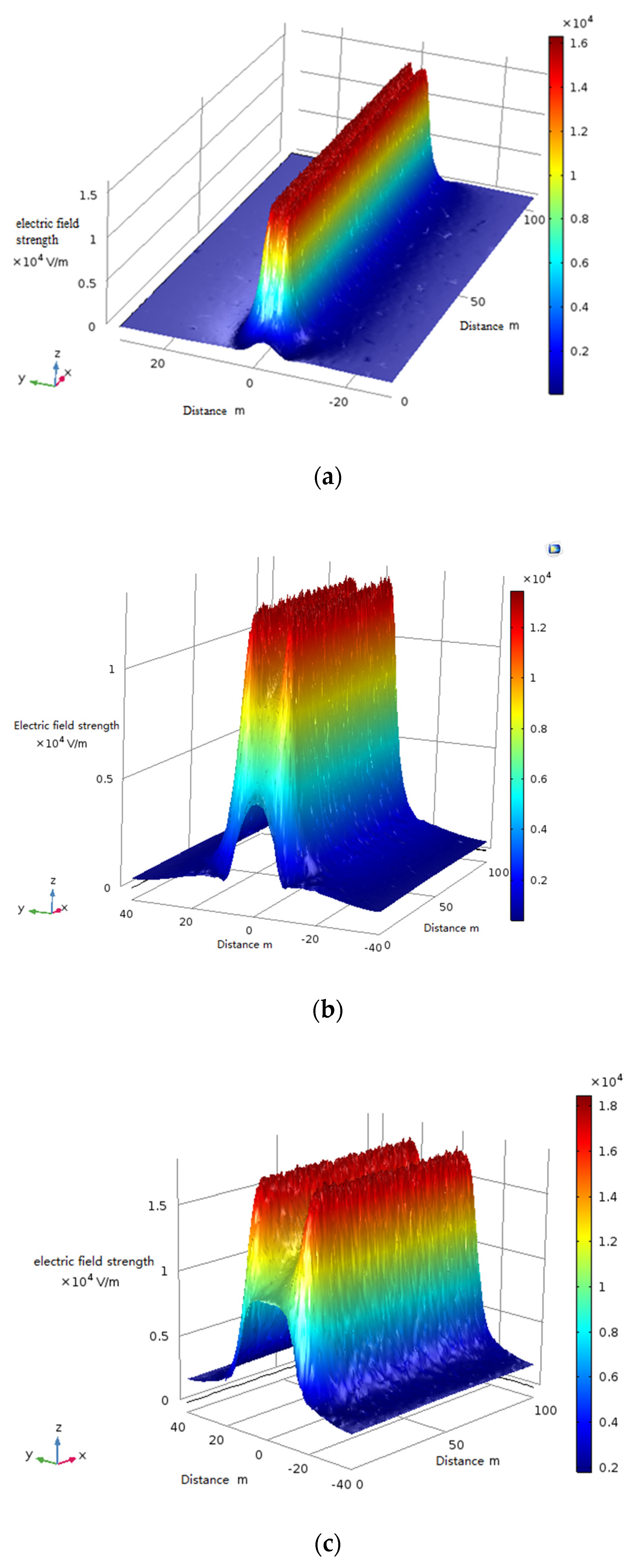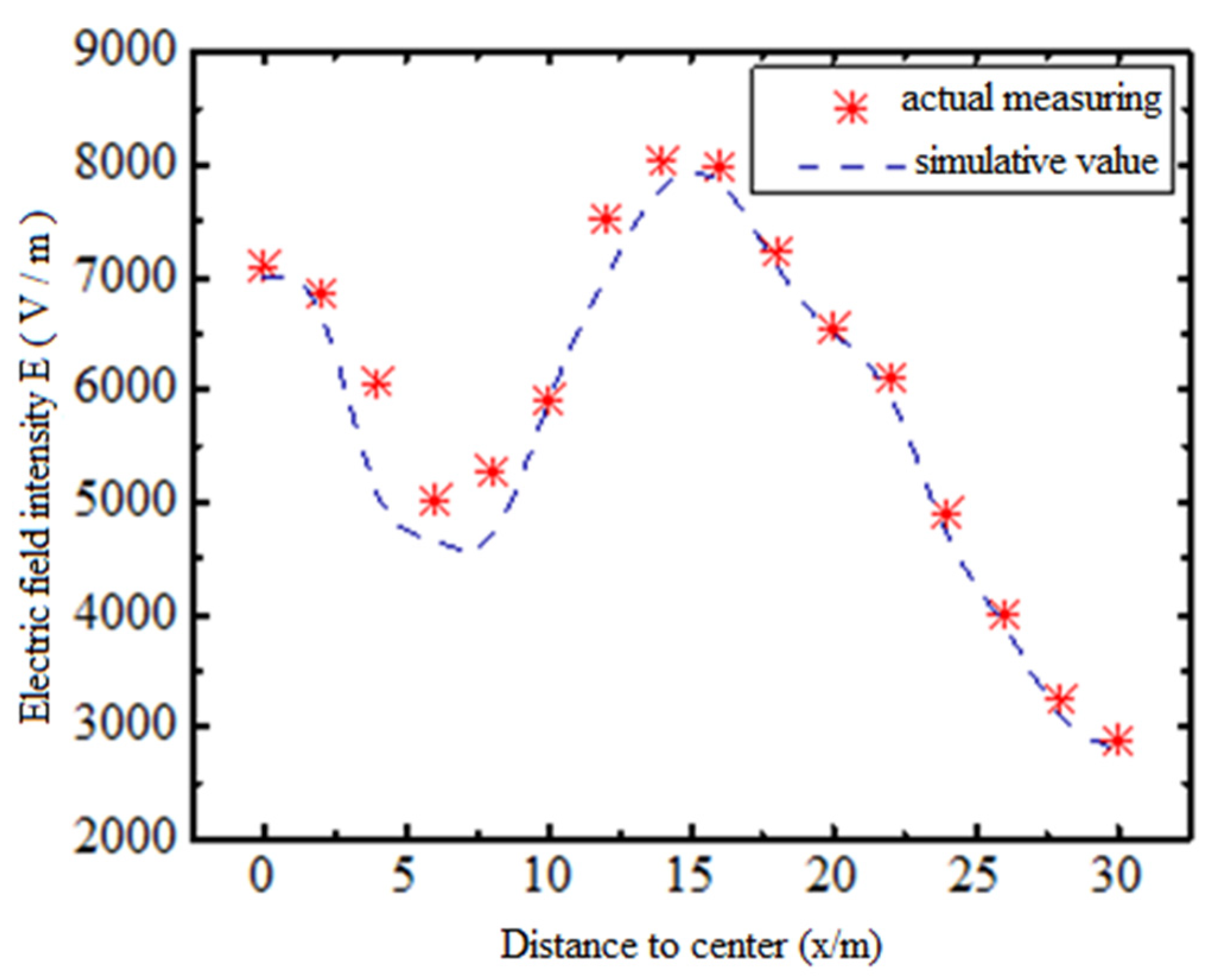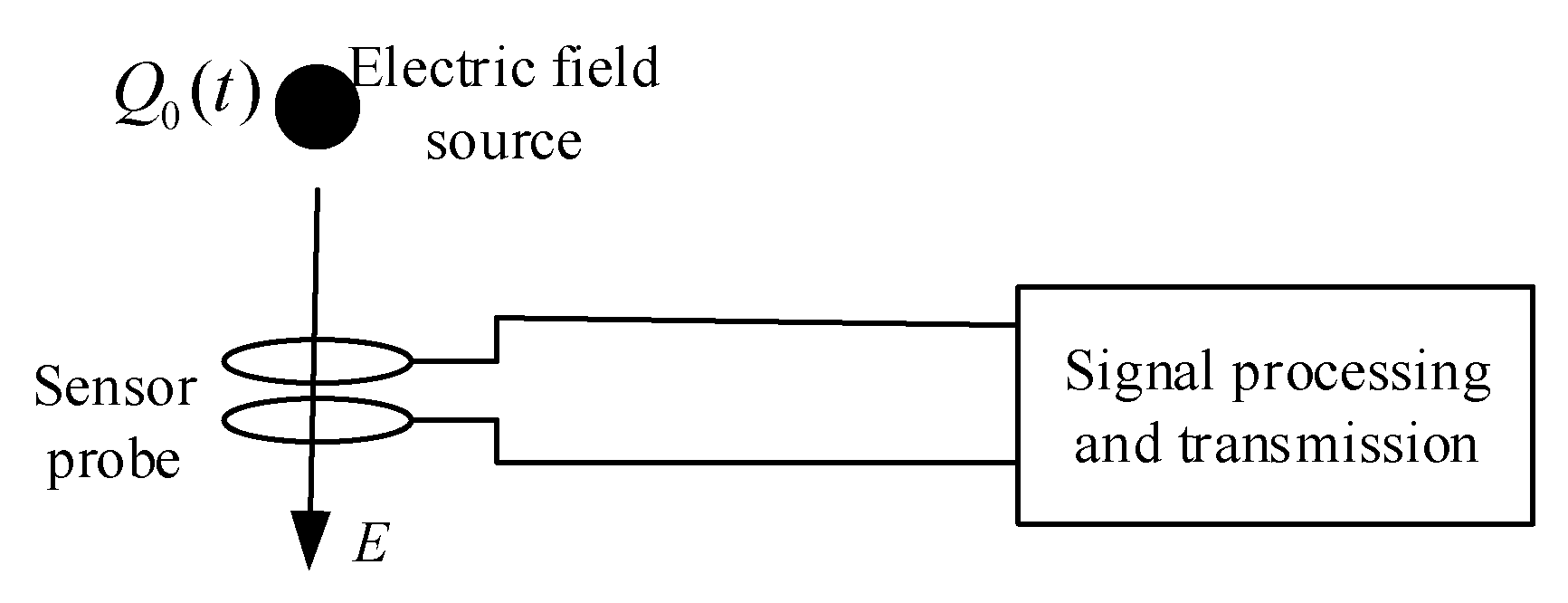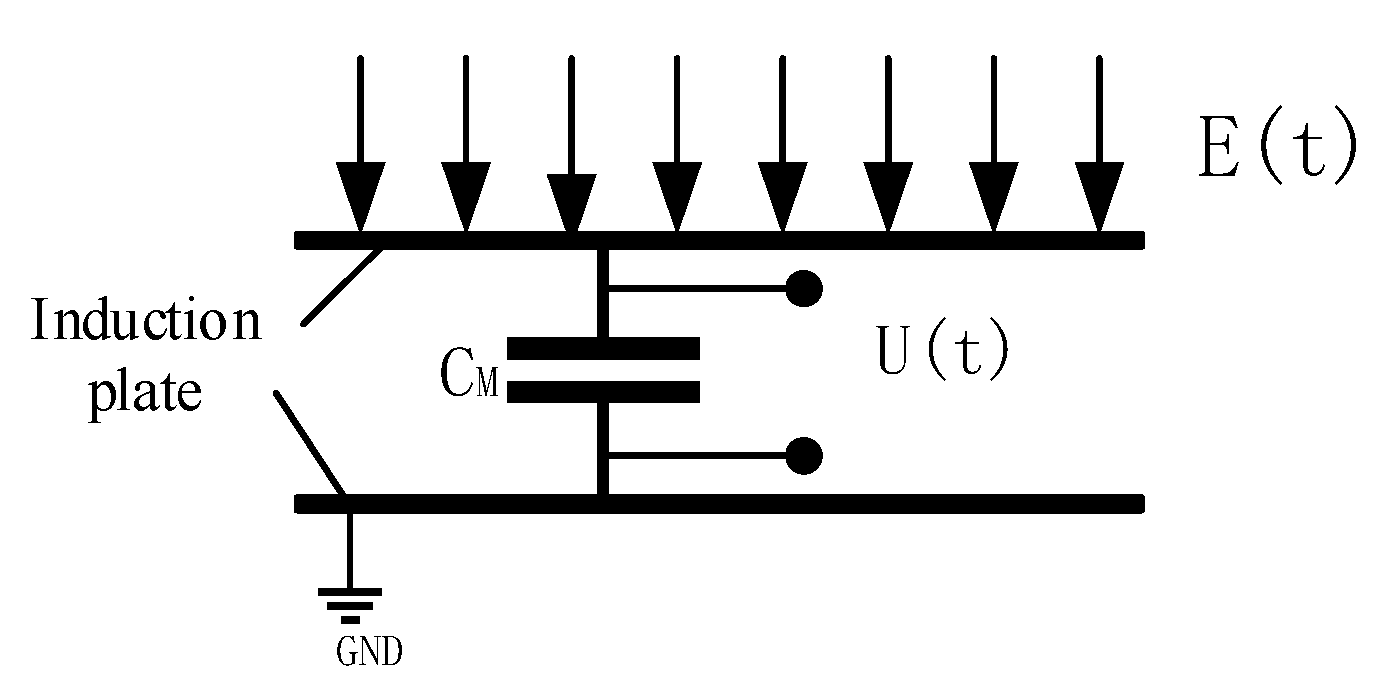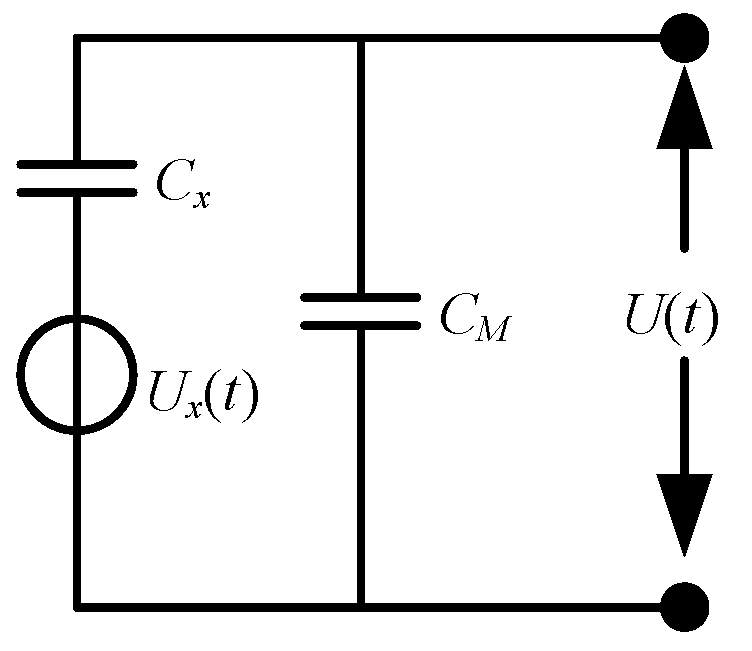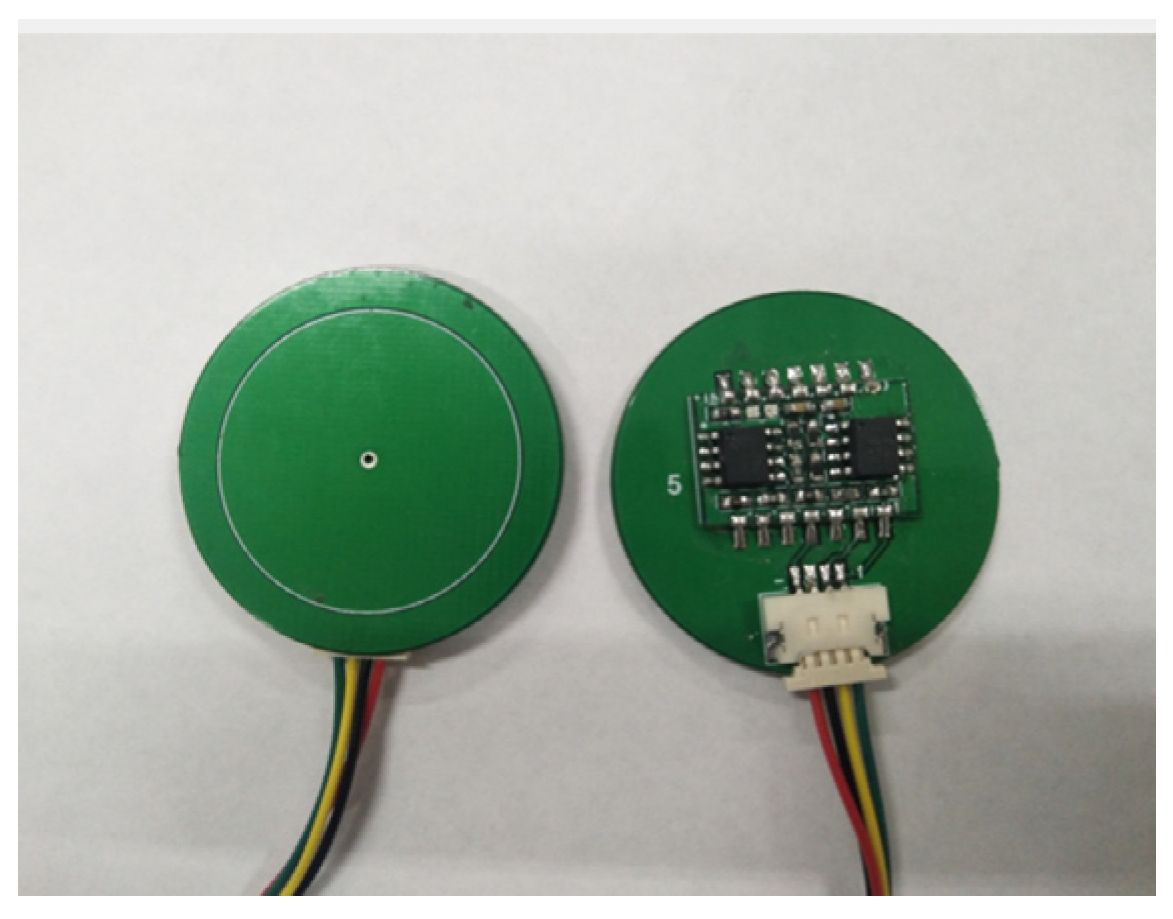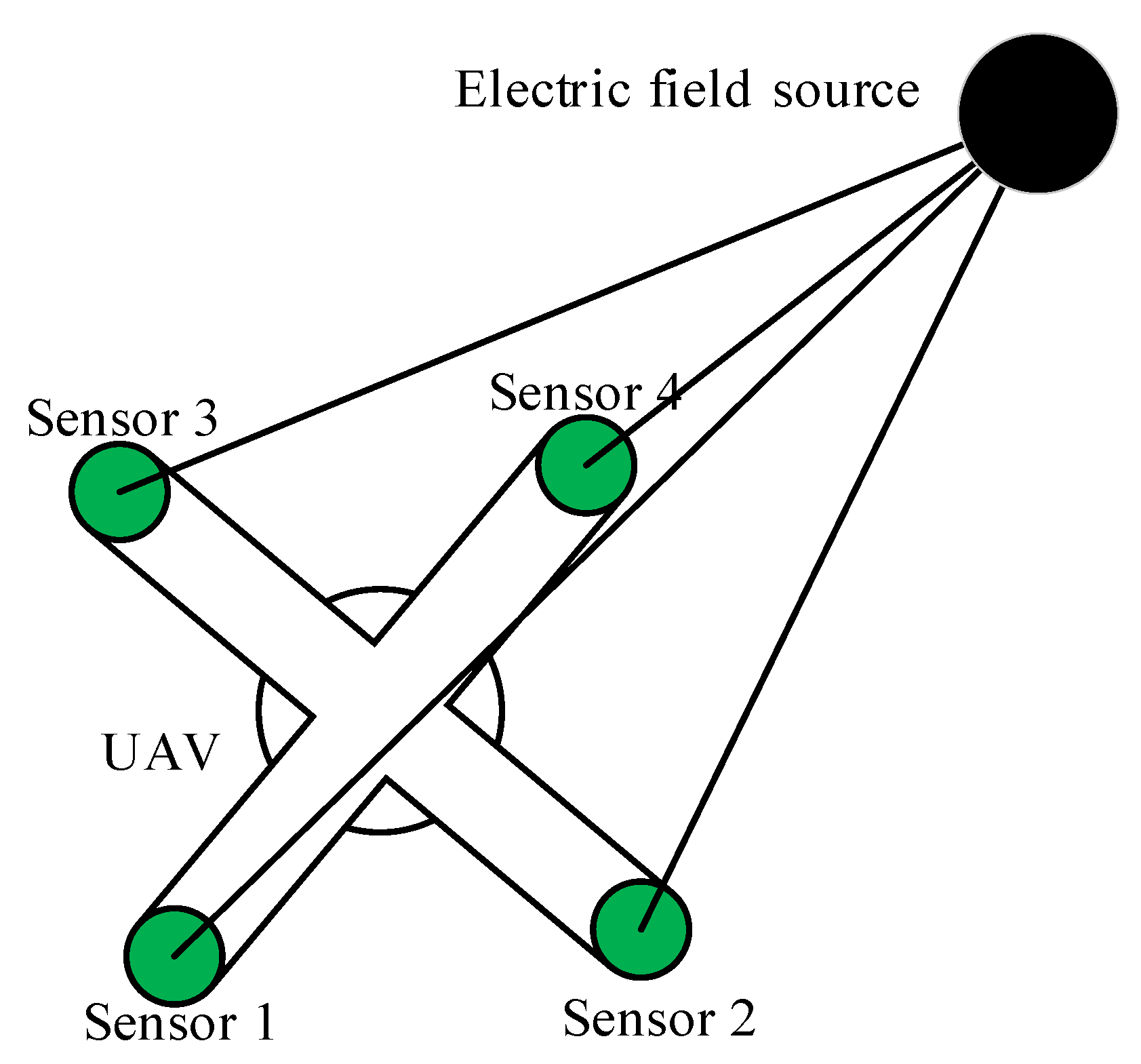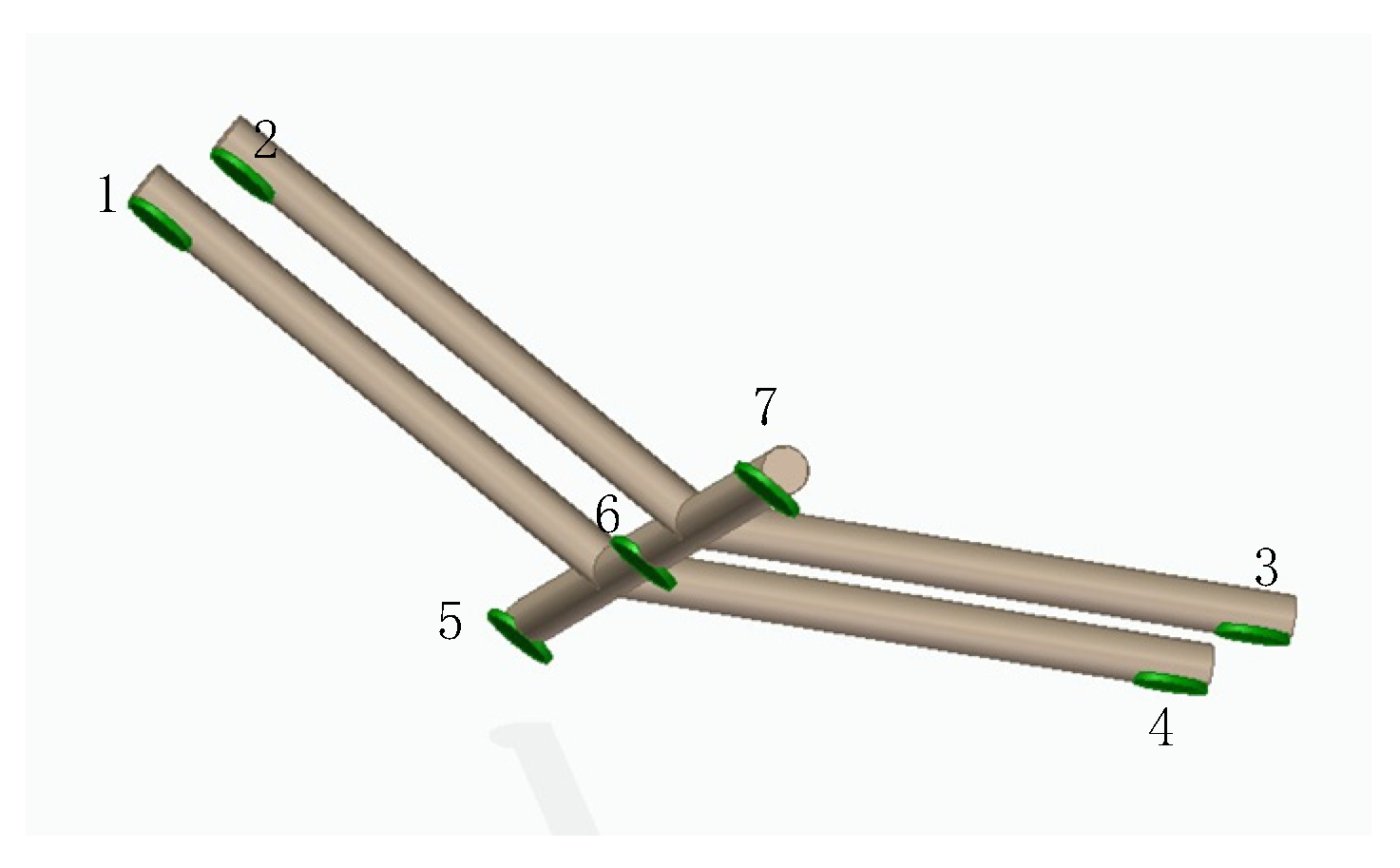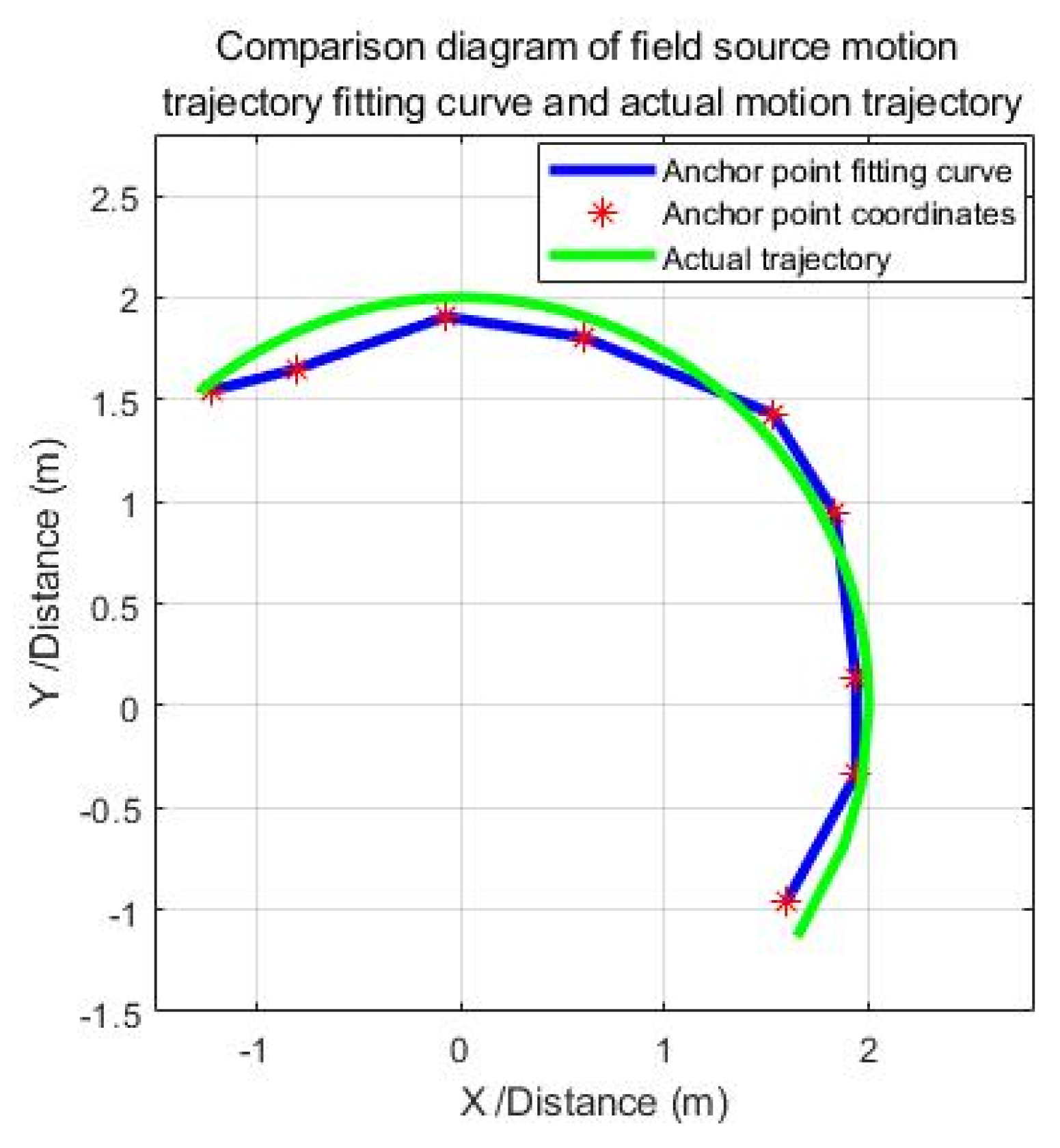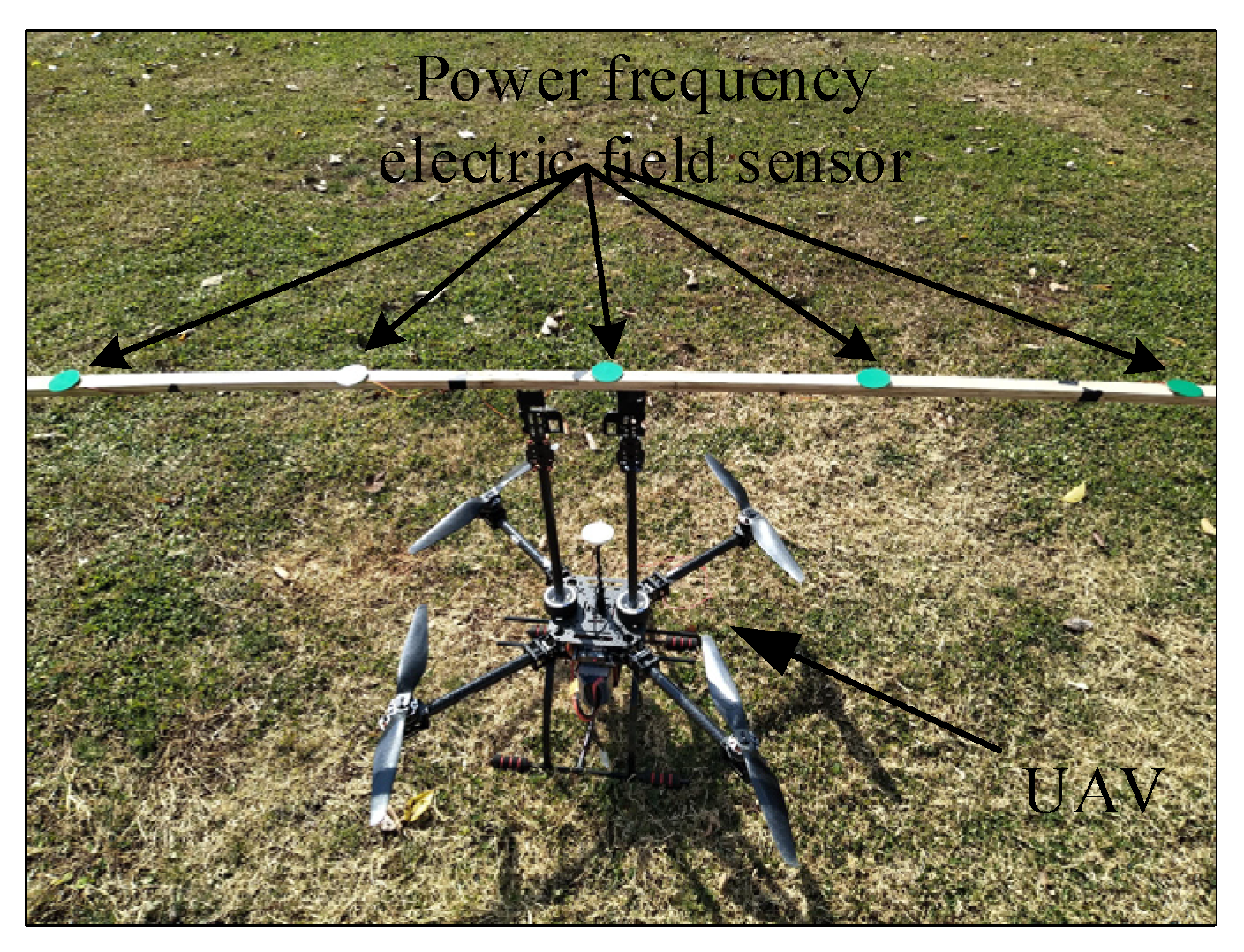1. Introduction
With the continuous expansion of overhead transmission lines and the rapid increase of coverage, the regional environment of overhead transmission lines is complex and diverse, which makes the operation and maintenance of overhead transmission lines more difficult. The traditional power transmission line inspection method has high strength, long cycle, high risk factors, and blind inspection area, which is difficult to meet the needs of modern power grid development [
1,
2]. Based on this, the unmanned aerial vehicle (UAV), as a scientific and efficient inspection method, has been widely concerned. Especially in recent years, a large number of academic and engineering applied research have been carried out to enable UAV to better complete advanced work such as search and rescue [
3], path planning [
4,
5], target tracking [
6,
7], and so on. In order to achieve autonomous navigation and intelligent obstacle avoidance, a variety of guidance, navigation, and control algorithms have been developed, which has laid the foundation for the application research of drones in power patrol inspection. Furthermore, UAVs are widely used by domestic and foreign power companies for inspection and reconnaissance of transmission lines due to their advantages such as strong maneuverability, simple control, diverse forms, high efficiency, and low cost [
8,
9,
10].
However, the current research based on UAV autonomous inspection of overhead transmission lines is still in its infancy. The main academic and engineering application research focuses on the detection of power transmission lines through UAVs equipped with lidar, visible light sensors, and infrared cameras, collecting fault data to provide navigation information for line patrol UAVs. The location and height of the data collected by the UAV depends on the vision of the flight control personnel and the detection results of these sensing devices. Therefore, the inspection of overhead transmission lines by UAVs depends heavily on the level of flight control of the control personnel, which is difficult to control manually and has low positioning accuracy, which affects aerial photography and status diagnosis [
11,
12,
13]. To a large extent, this limits the operational performance of UAVs, and cannot make good use of the advantages of UAVs’ strong maneuverability, flexible control and high efficiency.
Therefore, UAV autonomous inspection of overhead high-voltage transmission lines has been studied, hoping that UAVs can perform more advanced and optimized aerial inspection tasks [
14,
15,
16]. In these studies, the more feasible methods are the use of LiDAR technology and real-time kinematic (RTK) technology. Among them, LiDAR obtains high-precision 3D point cloud data of line channels to plan flight routes for autonomous inspection but extracting power line and tower information from disordered laser point clouds has a large amount of data processing. At this stage, it mainly depends on manual processing, the inspection efficiency is low [
17,
18,
19,
20,
21,
22]. Reference [
17] uses a UAV equipped with lidar to detect the transmission line, extracts the characteristics of the transmission line through the acquired point cloud data, calculates the distance between the UAV and the transmission line, and diagnoses the safe distance to ensure UAV safety inspection. Reference [
18] relies on artificially extracting features of ground objects from point cloud data and removing them, and then using the density features of the tower and transmission lines to locate the tower and transmission lines for navigation. Reference [
19] made statistics on the detected point cloud data, extracted the characteristics of the target object, and mapped it to a two-dimensional plane, and detected the long direct power line based on Hough transform. Using laser radar detection technology for UAV autonomous patrol navigation, it is necessary to classify point cloud data, extract feature data, analyze and calculate the relationship between transmission wire and other ground objects, and then provide navigation information for UAV autonomous patrol [
20,
21,
22]. RTK (real-time kinematic) technology can perform high-precision positioning for inspection UAVs, relying on RTK technology, the patrol UAV can perform patrol inspection according to the preset patrol inspection path, and achieve data collection at specific locations [
23,
24,
25]. RTK technology has laid the foundation for automatic inspection of UAVs. In engineering applications, the State Grid Corporation of China currently detects line channels based on lidar technology, and China Southern Power Grid Corporation uses CW-LiDAR to measure the safe distance of the wire to ground. However, these are only at the level of simple application of equipment, and more advanced inspection techniques still need to be studied in depth.
As airborne lidar systems are expensive, complicated to operate, and bulky, many small electric power companies cannot afford expensive costs and cannot implement large-scale application promotion [
26]. Extraction of power line features from image processing is a method with high feasibility, low cost, and easy to implement as navigation information for UAVs. Research on methods and technologies for extracting long and straight power lines from aerial images has been favored by scientific researchers and power companies [
27,
28,
29,
30]. These processing methods use visible light sensors to collect images or videos during the inspection process, based on the mathematical methods of image processing, the linear characteristics of long straight wires are extracted from the cluttered background. However, these methods have defects such as being susceptible to weather factors, large amount of data processing, low accuracy, and poor real-time performance. In order to realize autonomous navigation of inspection UAVs, some researchers also use GPS, ultrasonic sensors, ultraviolet, infrared, visible light sensors, and a combination of these sensors to conduct navigation research on inspection UAVs [
31,
32]. However, there are few studies on the field strength information of the space around the overhead transmission line as the navigation and obstacle avoidance of the UAV. Using the stable field strength around the transmission line as the information for the UAV’s obstacle avoidance navigation can effectively avoid the limitations of the traditional detection system with large volume and mass, which is not easy to carry on the drone. At the same time, it can also better solve the problems of the current inspection methods used, such as being greatly affected by environmental and weather factors, small wire diameter, difficult to detect, and difficult data processing.
In this paper, the field source positioning algorithm will be studied according to the electric field distribution rule around the transmission line, and the airborne power frequency electric field sensor and obstacle avoidance navigation system will be designed. Identify and locate the position of the field source from the detection and processing results of the field strength distribution information, and the diagnosis of the safety distance can realize the autonomous positioning navigation and safety warning during the UAV patrol inspection.
2. Materials and Methods
2.1. Analysis and Research of Navigation Information Mathematical Model
In order to accurately study the distribution rule of the electric field around the overhead transmission lines and provide accurate navigation information for the UAVs. It is necessary to model and analyze the transmission line and the field strength around the line according to the actual working conditions.
As shown in
Figure 1, the power lines between the two power towers are distributed in a catenary shape due to their own gravity and external environmental factors. Assuming that the suspension point of the conductor is the origin of the coordinate system, the direction of the wire is in the X-direction, and the vertical direction is the Z-direction, then the catenary equation of the transmission line can be expressed as [
33,
34,
35,
36]:
where,
Dh = 0 can be expressed as:
where,
σ0 is the stress at the lowest point of the overhang of the power line;
γ is the ratio of the force of gravity per wire length to the cross section of the wire; and
dh and
h are the horizontal and vertical distances of the two suspension points of catenary, respectively.
It can be seen from the formula that the catenary equation contains a conic curve function, which is complicated to calculate and not easy to use. In practical engineering, oblique parabolic or flat parabolic formulas are often used to erect high-voltage transmission lines, so catenary formulas are generally simplified to oblique parabolic formulas or flat parabolic formulas [
36]. The overhead transmission line studied in this subject has a small span, so a flat parabola is used instead of a catenary.
Assuming that the origin of the coordinates is the lowest point of the vertical line, the formula for flat parity is
where
h0 is the height of the lowest point of the wire.
The navigation and positioning system of UAVs accurately obtains navigation information, not only to establish an accurate spatial distribution model of wires, but to model and analyze the field strength information distributed around the wires. This study based on the idealized assumptions of the overhead transmission line model, according to the electrostatic field theory, comprehensive consideration of factors such as pitch, sag, and the layout of the conductors of each phase, the electric field generated by the high-voltage overhead transmission line in its surrounding space is analyzed. Assuming that a selected section of transmission line is used as the research object to analyze and calculate the field strength at a point in the surrounding space, the simulated charge type shown in
Figure 2 is a linear charge unit with a linear distribution of charge density [
37].
Assuming that the length of the line charge unit is
L and
A is the starting point, the coordinates of any point
C (
X,
Y,
Z) on the line unit can be expressed as Equation (4):
Of which,
the linear charge density at the beginning of the line unit is τ
1, and the linear charge density at the end of the line unit is
τ2, let
u = Lt (0 ≤
t ≤ 1), the linear charge density at any point on the line charge can be expressed as
Assuming the distance from the field source to the measurement point is
D.
Then the electric field strength generated by the line unit at any point P in the surrounding space is [
38,
39,
40].
where
Assuming a certain range of distances, the conductors of each phase are parallel to each other, and they are brought into the flat parabolic Equation (3) of the transmission line. Based on the Equation (8), the superposition theorem is used to calculate the electric field strength around the transmission line to obtain the system of Equation (10):
where
N is the
N-phase overhead transmission line. Then the electric field strength value of a point
P in space can be expressed as
It can be seen from the analysis of Equations (10) and (11) that the field strength at a certain point in space has a definite relationship with the position of the field source. According to the mathematical model between the field strength of the measuring point and the spatial coordinates of the field source, using the UAV detection system as the origin of the coordinate system to establish a spatial rectangular coordinate system can locate the change of the position coordinate of the field source. The UAV can be navigated and located by locking changes in the location of the field source. However, it is difficult to locate the field source at a specific point on the overhead transmission line with multi-phase conductors under actual working conditions. To solve this problem, this paper uses the method of equivalent electric field strength amplitude to solve the problem of difficult positioning of multi-phase transmission conductors. Supposing there is a unit length of overhead transmission line at a point A (x, y, z) in space that produces a certain field strength E at the measurement point, at another point in space B (x1, y1, z1) there is also a hypothetical equivalent point charge that also produces the same electric field strength at the same measurement point. The space coordinate B (x1, y1, z1) of the equivalent charge can be calculated by the electric field sensor measuring the electric field intensity value. Then, the coordinates of A (x, y, z) are converted and solved through the spatial coordinate conversion relationship, so as to realize autonomous obstacle avoidance and navigation of the UAV.
It is assumed that the measurement point is the origin of the measurement coordinates, where the X axis is the forward direction during the UAV inspection, and the Z axis is the vertical direction. The field strength at the measurement point can be expressed as:
Therefore, the field strength value at the measurement point can be expressed as
The spatial position coordinates of the hypothetical equivalent charge
Q′
0 are calculated and solved by the sensor measurement value. Then, the spatial position coordinates of the line charges that generate the same electric field strength are calculated by the mathematical model, so as to locate the field source position of the transmission line and navigate the line patrol UAV. The field strength relationship generated by the two equivalent models in space should satisfy the relationship shown in Equation (15):
2.2. Simulation Analysis of Electric Field Distribution Rule
Based on the above theoretical research, simulation software is used to simulate and analyze the effects of different voltage levels and different arrangement of transmission lines on the field strength distribution. The study found that with the same arrangement, the distribution of the electric field around transmission lines with different voltage levels is similar. The larger the voltage level, the higher the rate of change in electric field strength. The farther away from the transmission line, the smaller the rate of change in electric field strength, and the maximum field strength appears on the transmission line.
In this study, COMSOL simulation software is used to simulate and analyze the distribution law of electric field intensity around transmission lines with three voltage levels arranged horizontally. The analysis results are shown in
Figure 3.
The analysis results show that for the same arrangement, the electric field distribution around the transmission lines with different voltage levels is roughly the same. The electric field strength decreases gradually away from the transmission line, and the maximum electric field strength is on the transmission line. Due to the superposition of the electric field vectors generated by each phase conductor, the electric field intensity below the edge phase conductor is strong, and the electric field intensity contour intersects between the two transmission lines. However, the change rates of electric field strength are different with different voltage levels. The larger the voltage level is, the higher the change rate of electric field strength is. At the same time, the electric field intensity of different voltage levels at the same position is not the same, therefore, the safety distance of UAV inspection increases with the increase of voltage level.
As shown in
Figure 4, the field strength distribution of the 500 kV voltage level at 5 m above the transmission line is generally greater than the rate of change of the electric field strength of the two voltage levels of 220 kV and 110 kV.
As shown in
Figure 5, there are different arrangements of common single-circuit transmission wires. According to the established mathematical model for the calculation of the electric field of the high-voltage transmission line, MATLAB simulation software was used to simulate and analyze the distribution of the electric field at a location 6 m above the transmission line with different arrangement of 220 kV voltage levels. The calculation results are shown in
Figure 6.
As shown in
Figure 6, the electric field distribution of horizontally and inverted triangle transmission lines is similar, showing an "M" shape, and the transmission field of a transmission line with a regular triangular arrangement has a unimodal electric field distribution. An extreme value of the electric field intensity distribution will always appear near the mid-phase conductor. By extracting this important feature, the patrol path of the UAV can be located.
In practical engineering applications, the UAV’s trajectory cannot be completely maintained within the plane of the safe distance. The UAV may move up and down within the standard plane of the safety distance. Therefore, it is necessary to study the distribution law of electric field strength in the three-dimensional motion space of the UAV. Based on this, the field strength distribution law near the safety distance of 110 kV voltage level is selected for simulation analysis. The simulation analysis results are shown in
Figure 7. The three-dimensional electric field intensity distribution above transmission lines with different voltage levels is shown in
Figure 8.
According to the analysis in
Figure 7 and
Figure 8, it can be seen that the combined electric field strength curve along the X-axis direction along the top of the transmission line shows a hump shape in the same height range. Because the electric field vectors generated by the transmission conductors of different phases are superimposed on each other, an extreme value of the field strength distribution will always appear above or below the middle-phase conductor, and the closer to the conductor, the more obvious the distribution law and rate of change of the field strength. By detecting and identifying this abrupt point of field strength, the location of the transmission line as a field source can be achieved.
In order to verify the accuracy of the established simulation model and calculation method, the field strength signals collected under a certain actual working condition are compared with the established mathematical model. The collected data is the working condition of a relatively flat ground single-loop 500 kV overhead transmission line, and the measuring equipment is the low frequency electromagnetic field analyzer EHP-50 F and broadband measuring instrument NBM-550 of Narda company in Germany. The measuring equipment is installed in the position of 2 m away from the ground height, from the bottom of the transmission line lateral to the outside, the sampling point spacing in the measurement process is 2 m, the equipment is far from the obstacles such as the measuring personnel, reduce the influence on the electric field measurement, read the measurement data through the optical fiber communication interface, the measured results and the simulation results are shown in
Figure 9.
It can be seen from
Figure 9 that the measurement results have the same trend with the simulation results, and the maximum relative error is within 15%, which verifies the accuracy of the mathematical model analysis of field strength distribution and the rationality of the calculation method in this paper. The calculation error is within the allowable range of engineering application error.
2.3. Design and Research of Airborne Power Frequency Electric Field Sensor Probe
Collecting field strength distribution information around overhead transmission lines is used as a reference for UAV positioning and navigation and safety warning. It is necessary to design a portable power frequency electric field sensor suitable for UAVs for this application scenario. The schematic diagram is shown in
Figure 10.
According to the principle of electrostatic induction, a conductor located in an alternating electric field has a surface induced charge that changes with time at the same frequency as the electric field to be measured. Based on this induced charge, a voltage or current signal proportional to the electric field to be measured can be obtained, thereby realizing the measurement of the electric field.
The surface density of the induced charge on the probe is σ, ε
0 is the dielectric constant in the air, and the amount of induced charge generated by the change in the measured electric field strength
E(
t) is
Q(
t). This relationship can be expressed as [
38,
39].
where
S is the effective area of the induction plate.
The structure of the electric field induction unit designed according to this principle is shown in
Figure 11, which is composed of three parts: an upper plate, a lower plate, and a sampling capacitor. The equivalent circuit diagram is shown in
Figure 12. The physical diagram of the designed airborne power frequency electric field sensor is shown in
Figure 13.
According to the analysis of the equivalent circuit schematic diagram 10, The voltage signal
U(t) formed at the two ends of the sampling capacitor
CM by the induced charge generated on the sensing plate is used as the output signal, and their relationship can be expressed as
where
Cx is the inherent capacitance of the sensing unit, and
k is the correction factor related to the structure of the sensing unit.
From the analysis of Equations (14), (16), and (17), we can know that through the processing and calculation of the output voltage signal of the sensing unit, the electric field strength information and the induced charge of the detection electrode plate can be obtained.
3. Research on Positioning and Navigation Algorithms
In this paper, according to the distribution rule of electric field intensity, the field source positioning model is established by the method of signal array detection, and the spatial rectangular coordinate system is established with the measurement point as the origin. The location of the field source is P (x
0, y
0, z
0), according to the analysis of the measurement model of the sensor, it can be known that when the radius of the probe of the round sensor is much smaller than the distance between the sensor and the measurement point, the voltage signal output by the sensor has a relationship as shown in Equation (18) with the amount of charge carried by the field source.
where
U(t) is the voltage signal output by the sensor,
Q0(
t) is the amount of charge carried by the electric field source, and
P is the proportional constant related to the sensor parameters.
From the analysis of Equation (18), it can be seen that the output voltage signal of the sensor contains the spatial position information of the field source and the charge information of the field source. Therefore, only four equations need to be established to solve the four unknown parameters, and then to locate the relative position of the field source. According to the analysis, only four identical electric field sensors need to be installed in a specific layout relationship to form a measurement system to complete the solution of the field source spatial position. The measurement relationship of each sensor satisfies the Equation (18), and the simultaneous solution can obtain the Equation (19).
where
Di (
i = 1, 2, 3, 4) is the distance between the
i-th sensor and the field source.
The structure model of the constructed measurement system is shown in
Figure 14 [
41], where the position coordinates of the four sensor probes are (0,0,0), (L,0,0), (0,L,0), (L,L,0), each detection plate is a circle of area S, then the distance
Di (
i = 1, 2, 3, 4) between the field source and each detection plate can be expressed as
Simultaneous Equations (19)–(23) can solve the position coordinates of the field source:
It can be seen from the above equations that the field source position coordinates (x0, y0, z0) can be solved by the output voltage signal U of the sensor and the distance L between the sensors. Therefore, the accurate positioning of the relative position of the electric field source and the drone can be achieved, which can provide a reference for the UAV obstacle avoidance navigation and safety warning.
